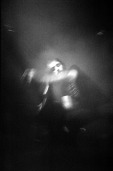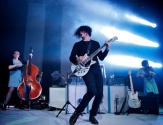Black Lips
With in mind the idea of a photographic project about East London Hipsters’ scene I decided to forget last year disastrous organization and ask for a photopass for the 1234 Shoreditch Festival, a one day event in the centre of East London coolness.

To get to the Shoreditch Park isn’t easy. Hidden among strands of council houses, what years ago was a no-entry London area nowadays it is a “you’re out if you do not enter” place.
Getting there on the festival day is as easy as finding the Samba schools parade during Rio de Janeiro carnival.
A girl from New Zealand arrived with some friends and candidly utters: “Why is everyone in fancy dress?”.
I wouldn’t want to be in her place listening to the “fancy-dressed” friends attempting to explain to her that those are not costumes but properly dressed people depicting a new urban figure blossoming in the East-London area.

To be cool to the philosophy, implies some key points. Mainly to work in new media, music, artistic and creative positions and devote yourself to the mission of being different.
The aim is to look as if they don’t care how they look.
Surreally enough the consequence is that they all look identical and care very much.
Worldwide they are better known as Hipster. In this particular area it is devaluated to Shoreditch twats.
Attitude is snob. If you’re out and don’t embody the culture and the look and the music, they snub you.

I have been wandering all day among guys wearing blue and white horizontal striped T-shirts, something between Pat Metheny in the 80s and a sailor in the 30s. The have curly moustaches, Ray Ban sunglasses (a must have item), cubist haircut, very low waist, skinny jeans regardless of the presence or not of a beer belly. Tore down converse All-Stars.
It is very important to look poor. The (expensive) All Saints shop in Spitafield is their fashion-temple but if you ask where they bought that cool t-shirt there is only one answer allowed: “I got it for a fiver from a charity shop”.
Which has to be read “I am poor but so clever and cool that I can dress very trendy spotting beautiful things that normal people give away.”
How different is that? Very, isn’t it?

In psychological terms, Transactional Analysis would categorize this into the “I am OK, you are not OK script” (I won’t get there).
They all have a cotton bag. It replaces the (too mainstream) t-shirt to hold the manifesto. Differentiation within the group is achieved choosing your cotton bag of choice. Unsurprisingly it is an added item to all bands’ merchandise.
Mission unaccomplished, though. The bag frequently is Rough Trade, rigorously East and inevitably made of Fair-trade, organic cotton.

It was probably since Punk heydays that London didn’t see a community so uniform in their… erm.. uniforms. With two key differences.
First, this fashion seems to be a male thing. Or maybe guys are just more easily distinguishable because of a less creative mind. Don’t know, Fact is men contradict the basis of their “philosophy”: “Being different” and are strolling Shoreditch park all looking identical. I must be missing some conceptual passage.
From the outside it appears a narcissistic world that unconsciously aims to hide a lack of self-confidence. It searches for recognition among its own group. Recognition that more often than not happens through a Twitter mention, a “like” on Facebook and… listen here, be cool, a +1 on Google+. To avoid the eye contact that they don’t seem to be able to keep, they spend most of their time interacting through smart phones.

Second, culturally more interesting, this phenomenon follows an opposite direction. Punk “revolution” was born with the music and brought the rebellion in the streets. This fashion brings its own idea of coolness, doesn’t aim at any revolution. The indie/being different works only if you are part of a small circle (google+ anyone?). No revolution, no mass recruitment, the opposite jealousy of their own items, music, places. Reluctance to admit newbie.
It was not not born with its music. It went out there looking for a music to identify with.

It’s indie, is not well known, it is hi-tech but sounds vintage and lo-fi.
From the bands’ perspective the sensation I get reading interviews is of detachment, when not run away. Most of the interviews I read of “east-London-approved” bands they state they are not part of any culture and do not want to be associated with any youth movement. The classic response you get from who realizes that it is in their interest not to be part of something that in a year time can be replaced by something different, likely opposite. Remember “Emo”?

To reject my eccentric theory on indie-bands personality and to stop me writing nonsense sociology arrived, punctual, the American insolence.
From the moment Black Lips enter the stage and throw beer cans to the audience I get back in touch with the importance of the transfer between the artist and its audience.
Black Lips arrive in London with a critically acclaimed new album, Arabia Mountain. I must admit I wasn’t particularly struck by this LP.
As the legend wants, I saw the light listening to it live.
Black Lips are a rare band. The funniest live act I saw in the indie stratosphere since Hives’ decline.

Their lo-fi punk-rock and the theatrical body language get the entire crowd jumping in seconds. Their songs have the power to wipe all those coloured Ray-Ban much quicker than the setting sun.
A relentless army of crowd-surfers takes off riding the wave of raised hands from the soundboard to land in the arms of security standing in the pit.
Black Lips play all songs at the fast rhythm that characterize their sound and the excitement does never have the options to slow down.
If this is not enough, midway through the show several people materialize on stage and start throwing hundreds of rolls of toilet paper.
The fans don’t ask for permission to hit back sending those three plies of softness back onto the stage. The carnivalesque consequence is a battle of toilet rolls going on for minutes soundtracked by Black Lips insolent tunes.
Brilliant!

Unsurprisingly at the end of the show Code Alexander, one of the guitarists, jumps off the high stage to salute the first row fans and kiss the lips of all the girls one after the other. Rock’n’roll!
He stops sharing phone numbers and fixing after-show party meetings with more than a few of them.
All happens in front of the eyes of the moustached (boy-)friends, shocked and nervously smiling into their vintage t-shirts.
The tale ends with the expected moral. Substance wins over appearance or, put it this way, 2011 groupies believe there is a time for façade and one for matter. Ray-Ban sunglasses are back on. It’s dark.
More about the Black Lips impertinence here [website][myspace][facebook][twitter]

Photo tip
From a concert photographer perspective this year organization was perfect.
Myself and all credited photographers could shoot the entire festival.
Black Lips were the headliners and there where no limits whatsoever. “Policy is very relaxed” told the press girl at the box office handing the photopass with a smile.

There was not a three songs limit, not a “no-flash” restriction, not a single rights grab form in place.
Who knows if it was lesson learnt from last year 1234 Shoreditch. Peter Hook, the Joy Division bassist, had a rights grab form and many photographers turned him down covering the rest of the event but his show.

Has this policy killed the music?
Has this ruined bands reputation?
Has this turned us, concert photographers into billionaire exploiting the band and earning millions selling their exclusive prints?
Of cours it hasn’t. Not at all.
No one has asked to buy a single of my Black Lips shots despite these being among my favourites concert pics ever.

The only consequence this policy had is very simple. There are much better photos of the 1234 2011 edition around.
The coverage, photographically, is much better than average.
Try to Google for reviews and images on music magazines (official images not fans iphone photos) and judge yourself.
It is not because concert photographers were all of a sudden inspired by the atmosphere or the bands more spectacular than usual. No, not at all.
It is because we had time to photograph the shows without pressure. Time to wait for the moment.

As everyone following live music knows well (and bands, managers and tour crew should know better) the best concerts’ moment never happens in the first three songs (unless a performer is doing it on purpose for the photographers). In fact most of the shots of this selection have been taken from the middle to the end.
If I had to post this with a three songs limit, there would not be any of these images just worse.
Having time to study the body language of the musicians, their moves, their behaviour and wait they got in the mood with the audience is of enormous help.
With a “three songs no flash policy in place” apart from the extent of my portfolio, who would have paid the price? Me or the Black Lips?
Discuss…









great photos, awesome band, simple and direct songs…..what more do you want ??????
Check out our Black Lips rock poster
http://tworabbits.bigcartel.com/product/black-lips-rock-poster
Hey there, thank you very much for this article. I am interested in the design you are using. Could you send me an email?
I think this is a actual great post.Really looking forward to read more. Really Cool.